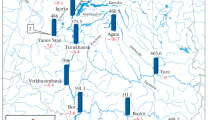Abstract
Landscape and climate conditions of mountain rivers lead to high and long-lasting floods that sometimes result in ecological deformation and cause immeasurable damage to the environment and enormous economic loss for the country. Therefore, their forecast is of high scientific and economic importance. For the above reasons, a prognostic method based on the statistical model was worked out. The optimum system of predictors is selected from their potential set using various mathematical criteria. By means of the direct and backward development of multi-factor dependences, the following regularities are investigated simultaneously: the decrease in the number of predictors, the increase in the lead time and accuracy, and the possibility of ignoring accompanying factors that arise in the corresponding lead time. Different prognostic equations taking account of the differences in data, the lead time and accuracy are derived for each hydrological section and region.
Similar content being viewed by others
References
G. A. Alekseev, Objective Methods of Smoothing and Normalization of Correlation (Gidrometeoizdat, Leningrad, 1971) [in Russian].
Ts. Z. Basilashvili, “Statistical Analysis of Variables and Selection of Predictors for Prognostic Dependences,” in Annotated Index of Algorithms and Programs (VNIIGMI-MTsD, Obninsk, 1977) [in Russian].
Ts. Z. Basilashvili and I. G. Plotkina, “Determination of Multi-Factor Dependences with the Development of Equations, Their Quality Assessment, and Computation of Probabilistic Forecasts,” in Annotated List of New Arrivals to Goskomgidromet OFAP, Issue 4 (VNIIGMI-MTsD, Obninsk, 1985) [in Russian].
N. R. Draper and H. Smith, Applied Regression Analysis (Statistika, Moscow, 1973) [in Russian].
Manual for Forecasting Service, Chapter 3, Part 1 (Gidrometeoizdat, Leningrad, 1962) [in Russian].
Ts. Basilashvili, “Forecasting of the River Run-off without Account of Current Hydrological Information,” Bull. Georg. Acad. Sci., No. 3, 163 (2001).
Ts. Basilashvili, “The Method of Working-out Hydrological Prognosis in Conditions of Limited Information,” Bull. Georg. Acad. Sci., No. 1, 162 (2000).
Author information
Authors and Affiliations
Corresponding author
Additional information
Original Russian Text © Ts.Z. Basilashvili, 2014, published in Meteorologiya i Gidrologiya, 2014, No. 6, pp. 61–66.
About this article
Cite this article
Basilashvili, T.Z. The forecast of the runoff of georgian mountain rivers under conditions of the sparse observational network. Russ. Meteorol. Hydrol. 39, 402–406 (2014). https://doi.org/10.3103/S1068373914060065
Received:
Published:
Issue Date:
DOI: https://doi.org/10.3103/S1068373914060065




